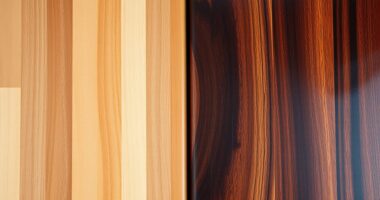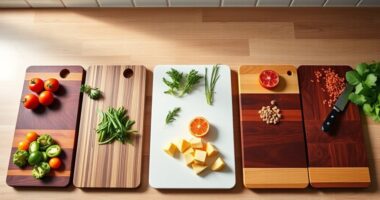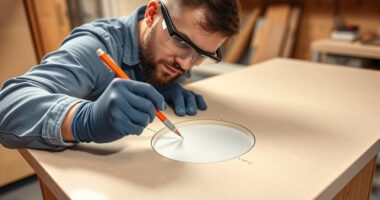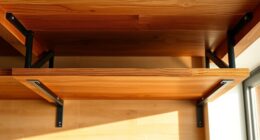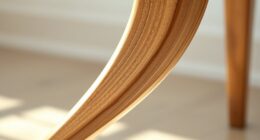When choosing a wood backsplash, consider beadboard for a classic, affordable look that’s simple to install, or shiplap for a rustic, modern vibe with visible joints. Sealed panels offer a sleek, seamless appearance but tend to cost more and might need professional help. Your style, budget, and DIY skills influence your options. Want to explore more about these choices and how they can transform your kitchen? Keep exploring to discover the best fit for your space.
Key Takeaways
- Beadboard offers an affordable, traditional look, easily DIY-installed with minimal seams.
- Shiplap provides a rustic, modern charm with visible tongue-and-groove edges, slightly higher in cost.
- Sealed panels create a sleek, seamless, contemporary appearance but are more expensive and often require professional installation.
- Cost varies: beadboard is most budget-friendly, shiplap is mid-range, and sealed panels are typically pricier.
- Style choice depends on desired aesthetic—classic, rustic, or modern—and installation skill level.
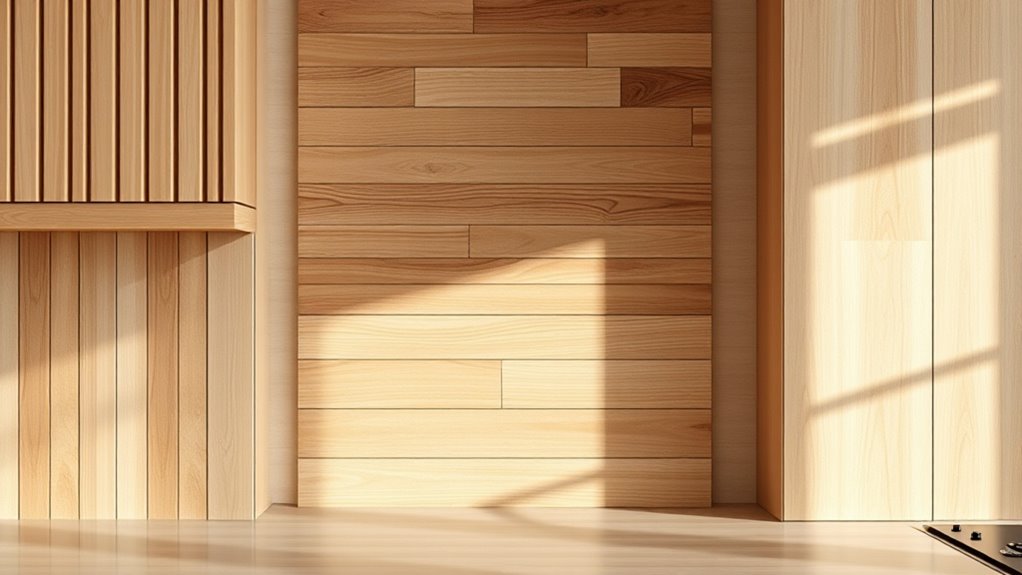
Are you considering a wood backsplash to add warmth and texture to your kitchen? Choosing the right style can transform your space, but it’s essential to weigh your options carefully. Beadboard, shiplap, and sealed panels each bring a unique look and feel, along with different cost implications and installation needs. Understanding the cost comparison between these options can help you make an informed decision that fits your budget. Beadboard tends to be the most affordable, especially if you opt for pre-cut panels or DIY installation. It’s typically priced per square foot and can be found at most home improvement stores. Shiplap, while slightly more expensive, offers a rustic, modern charm that many homeowners love. Its cost varies depending on the wood species and whether you choose pre-made planks or custom-cut options. Sealed panels, which are often made from plywood or MDF with a protective finish, can be pricier but provide a sleek, seamless appearance that’s easy to clean and maintain.
When it comes to installation tips, your approach can influence both the final look and the overall cost. Beadboard is usually the easiest to install if you’re comfortable with basic tools; it can be nailed or glued directly onto the wall, and seams are minimized with proper spacing and caulking. For shiplap, you’ll want to pay attention to aligning the tongue-and-groove edges for a tight fit, which can require a bit more patience but results in a visually appealing finish. Sealed panels demand a precise measurement and cutting process to ensure seamless installation, and because they often come in large sheets, it’s best to have a helper for handling and positioning. Regardless of the type you choose, prepping your wall properly—clean, smooth, and free of debris—will make installation smoother and result in a more polished look.
Choosing natural materials like wood adds authentic charm and warmth to your space, elevating the overall aesthetic. If you’re tackling the project yourself, invest in quality tools like a saw, level, and adhesive suitable for wood. Taking your time to measure accurately and follow manufacturer instructions helps avoid costly mistakes. For those less confident in DIY work, hiring a professional might seem more expensive upfront but can save you time and ensure a flawless result. Ultimately, your choice between beadboard, shiplap, and sealed panels hinges on your style preferences, budget, and DIY skills. Each offers a distinctive aesthetic and varying installation complexity, so weigh these factors carefully. Whether you go for the classic charm of beadboard, the rustic appeal of shiplap, or the sleek sophistication of sealed panels, a wood backsplash can truly elevate your kitchen’s look while adding warmth and character.
Frequently Asked Questions
How Do I Maintain and Clean Wood Backsplash Surfaces Effectively?
To maintain and clean your wood backsplash, use gentle cleaning techniques like a soft cloth or sponge with mild soap and water. Avoid harsh chemicals that can damage the wood. Regularly wipe down the surface to prevent dirt buildup, and promptly clean spills to prevent stains. For maintenance tips, consider applying a protective sealant periodically. This keeps your wood backsplash looking beautiful and ensures its longevity over time.
Can I Install a Wood Backsplash in a High-Moisture Kitchen?
Yes, you can install a wood backsplash in a high-moisture kitchen if you choose moisture-resistant wood and apply water-resistant treatments. Make sure to seal the wood thoroughly with a good-quality sealant or water-resistant finish, and reapply as needed. Proper ventilation and regular cleaning also help prevent moisture buildup. With these precautions, your wood backsplash can withstand the humid environment and stay beautiful over time.
What Are the Best Protective Finishes for Wood Backsplashes?
Think of your wood backsplash as a delicate garden needing a sturdy shield. The best protective finishes are clear polyurethane or oil-based sealants, which act like armor against moisture and stains. Wood treatment with these protective coatings preserves the natural beauty while safeguarding it from water damage. Regular reapplication keeps your backsplash resilient and vibrant, ensuring it remains a stunning focal point in your kitchen for years to come.
How Do I Prevent Wood From Warping Over Time?
To prevent wood from warping over time, you need to manage wood expansion and moisture control. Make certain your backsplash is well-sealed with a protective finish that repels moisture, and avoid exposing it to excessive humidity or water. Use proper ventilation in your kitchen, wipe spills promptly, and consider applying a waterproof sealant periodically. These steps help stabilize the wood and minimize warping caused by moisture fluctuations.
Are There Eco-Friendly or Sustainable Wood Options Available?
Yes, there are eco-friendly wood options for your backsplash. You can choose reclaimed wood, which repurposes old materials, reducing waste and environmental impact. Bamboo paneling is another sustainable choice because bamboo grows quickly and regenerates rapidly. Both options add natural beauty to your space while supporting eco-conscious living. By selecting reclaimed wood or bamboo, you prioritize sustainability without sacrificing style or durability in your kitchen design.
Conclusion
Choosing the right wood backsplash is like selecting the perfect frame for a masterpiece—you want it to complement your style and make your space shine. Whether you opt for charming beadboard, rustic shiplap, or sleek sealed panels, each option adds warmth and character to your kitchen. Think of your backsplash as the jewelry for your walls—an accent that pulls everything together beautifully. Trust your instincts and enjoy creating a space you love.


